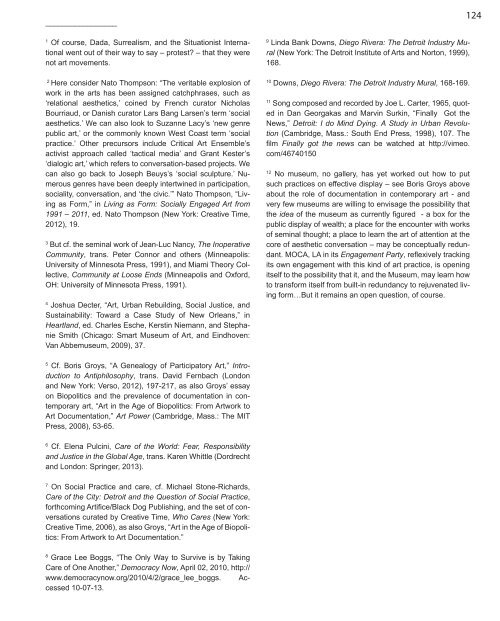Detroit Research Volume 1
You also want an ePaper? Increase the reach of your titles
YUMPU automatically turns print PDFs into web optimized ePapers that Google loves.
_________________<br />
1<br />
Of course, Dada, Surrealism, and the Situationist International<br />
went out of their way to say – protest – that they were<br />
not art movements.<br />
2<br />
Here consider Nato Thompson: “The veritable explosion of<br />
work in the arts has been assigned catchphrases, such as<br />
‘relational aesthetics,’ coined by French curator Nicholas<br />
Bourriaud, or Danish curator Lars Bang Larsen’s term ‘social<br />
aesthetics.’ We can also look to Suzanne Lacy’s ‘new genre<br />
public art,’ or the commonly known West Coast term ‘social<br />
practice.’ Other precursors include Critical Art Ensemble’s<br />
activist approach called ‘tactical media’ and Grant Kester’s<br />
‘dialogic art,’ which refers to conversation-based projects. We<br />
can also go back to Joseph Beuys’s ‘social sculpture.’ Numerous<br />
genres have been deeply intertwined in participation,<br />
sociality, conversation, and ‘the civic.’” Nato Thompson, “Living<br />
as Form,” in Living as Form: Socially Engaged Art from<br />
1991 – 2011, ed. Nato Thompson (New York: Creative Time,<br />
2012), 19.<br />
3<br />
But cf. the seminal work of Jean-Luc Nancy, The Inoperative<br />
Community, trans. Peter Connor and others (Minneapolis:<br />
University of Minnesota Press, 1991), and Miami Theory Collective,<br />
Community at Loose Ends (Minneapolis and Oxford,<br />
OH: University of Minnesota Press, 1991).<br />
4<br />
Joshua Decter, “Art, Urban Rebuilding, Social Justice, and<br />
Sustainability: Toward a Case Study of New Orleans,” in<br />
Heartland, ed. Charles Esche, Kerstin Niemann, and Stephanie<br />
Smith (Chicago: Smart Museum of Art, and Eindhoven:<br />
Van Abbemuseum, 2009), 37.<br />
9<br />
Linda Bank Downs, Diego Rivera: The <strong>Detroit</strong> Industry Mural<br />
(New York: The <strong>Detroit</strong> Institute of Arts and Norton, 1999),<br />
168.<br />
10<br />
Downs, Diego Rivera: The <strong>Detroit</strong> Industry Mural, 168-169.<br />
11<br />
Song composed and recorded by Joe L. Carter, 1965, quoted<br />
in Dan Georgakas and Marvin Surkin, “Finally Got the<br />
News,” <strong>Detroit</strong>: I do Mind Dying. A Study in Urban Revolution<br />
(Cambridge, Mass.: South End Press, 1998), 107. The<br />
film Finally got the news can be watched at http://vimeo.<br />
com/46740150<br />
12<br />
No museum, no gallery, has yet worked out how to put<br />
such practices on effective display – see Boris Groys above<br />
about the role of documentation in contemporary art - and<br />
very few museums are willing to envisage the possibility that<br />
the idea of the museum as currently figured - a box for the<br />
public display of wealth; a place for the encounter with works<br />
of seminal thought; a place to learn the art of attention at the<br />
core of aesthetic conversation – may be conceptually redundant.<br />
MOCA, LA in its Engagement Party, reflexively tracking<br />
its own engagement with this kind of art practice, is opening<br />
itself to the possibility that it, and the Museum, may learn how<br />
to transform itself from built-in redundancy to rejuvenated living<br />
form…But it remains an open question, of course.<br />
124<br />
5<br />
Cf. Boris Groys, “A Genealogy of Participatory Art,” Introduction<br />
to Antiphilosophy, trans. David Fernbach (London<br />
and New York: Verso, 2012), 197-217, as also Groys’ essay<br />
on Biopolitics and the prevalence of documentation in contemporary<br />
art, “Art in the Age of Biopolitics: From Artwork to<br />
Art Documentation,” Art Power (Cambridge, Mass.: The MIT<br />
Press, 2008), 53-65.<br />
6<br />
Cf. Elena Pulcini, Care of the World: Fear, Responsibility<br />
and Justice in the Global Age, trans. Karen Whittle (Dordrecht<br />
and London: Springer, 2013).<br />
7<br />
On Social Practice and care, cf. Michael Stone-Richards,<br />
Care of the City: <strong>Detroit</strong> and the Question of Social Practice,<br />
forthcoming Artifice/Black Dog Publishing, and the set of conversations<br />
curated by Creative Time, Who Cares (New York:<br />
Creative Time, 2006), as also Groys, “Art in the Age of Biopolitics:<br />
From Artwork to Art Documentation.”<br />
8<br />
Grace Lee Boggs, “The Only Way to Survive is by Taking<br />
Care of One Another,” Democracy Now, April 02, 2010, http://<br />
www.democracynow.org/2010/4/2/grace_lee_boggs. Accessed<br />
10-07-13.





